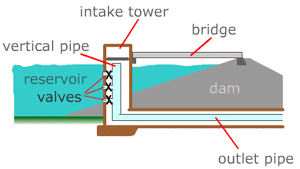- The first piece of news is very sad in my opinion, because it explains the serious deterioration the Roman remains of Acinipo, located 20 kilometers from Ronda (Málaga). The lack of investments to preserve this remains has put the site at risk

More information:

More information:
http://www.theolivepress.es/spain-news/2014/10/08/rondas-roman-ruins-future-in-jeopardy-says-spanish-heritage-group/
- The second report is about the remains of the Roman dam in Consabura (present day Consuegra). A group of archeologists has started exploring the remains of this dam and they think they have located one of the intake towers. This dam was one of the biggest the Romans built in Europe and it had the largest wall in Hispania, 700 meters long. The dam was built on River Amarguillo and it completely changed this dry area, because it allowed the development of irrigation agriculture.

Here you have a drawing to understand the concept of intake tower (torre acuaria in Spanish):

Source: http://www.ideers.bris.ac.uk/glossary/gloss_intaketower.html

And this is a link in English with collects all the information about the Roman dams in Hispania:
- A recent research has confirmed that the bust of Emperor Augustus found in the Roman city of Pollentia (Balearic Islands) in the 16th century was sculpted in the 1st century AD. This means that this statue of the first Roman emperor is the oldest imperial statue located in Hispania.The government of the Balearic Islands has decided to acknowledge the statue National Historic Interest, in order to avoid that Augustus bust being sold at auction in New York.

- The last piece of news is related to the use of the imperial past of Rome to extol dictatorships. In 1937 Fascist Italy celebrated the second millenary of the birth of Emperor Augustus and dictator Benito Mussolini gave a lot of copies of the statues of this emperor as present to his friends. Mussolini liked to compare himself with Augustus and promoted the idea that under his rule Italy was recovering the splendour of the Roman Empire. When the Civil War ended, Spain received a lot of copies of statues of the Roman emperors. Most of them were statues of Augustus, but there were also other statues of emperors linked with ancient Hispania. The falangists were particularly interested in comparing the rise of the Roman Empire and the Hispanic Empire of the Modern Era and there were frequent comparisions between Franco and Emperor Augustus. In their opinion, the "caudillo" had won the war and brought peace, as Augustus had done in the Roman Empire. That's the reason why you can find many statues of Roman emperors in different cities in Spain. Here you have a picture of the copy of Prima Porta Augustus statue in Zaragoza

Source: https://es.noticias.yahoo.com/blogs/arte-secreto/la-estatua-de-augusto-que-mussolini-regal%C3%B3-a-zaragoza-210001156.html
No comments:
Post a Comment